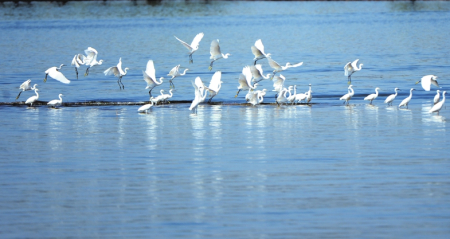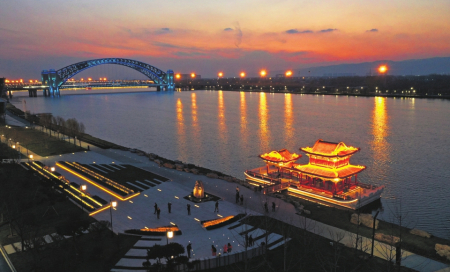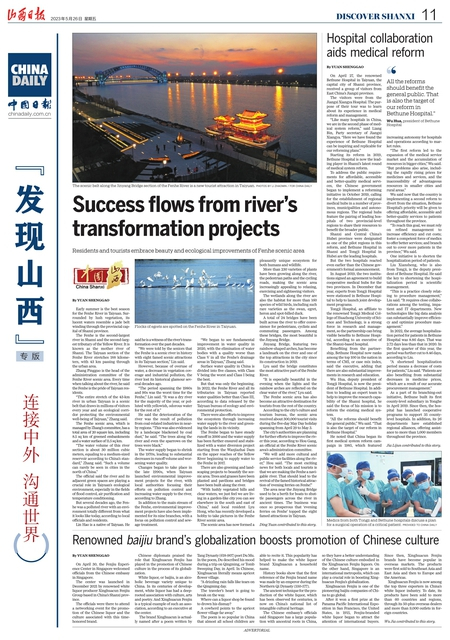Success flows from river’s transformation projects
Residents and tourists embrace beauty and ecological improvements of Fenhe scenic area

Flocks of egrets are spotted on the Fenhe River in Taiyuan.

The scenic belt along the Jinyang Bridge section of the Fenhe River is a new tourist attraction in Taiyuan. Photos by Li Zhaomin / For China Daily
Early summer is the best season for the Fenhe River in Taiyuan. Surrounded by lush vegetation, its lucent waters resemble a jade belt winding through the provincial capital of Shanxi province.
The Fenhe is the second-largest river in Shanxi and the second-largest tributary of the Yellow River. It is known as the mother river of Shanxi. The Taiyuan section of the Fenhe River stretches 188 kilometers, with 43 km passing through the urban area.
Zhang Pingguo is the head of the administration committee of the Fenhe River scenic area. Every time when talking about the river, he said the Fenhe is the pride of Taiyuan residents.
"The entire stretch of the 43-km river in urban Taiyuan is a scenic belt that draws in millions of visitors every year and an ecological corridor protecting the environmental well-being of Taiyuan," Zhang said.
The Fenhe scenic area, which is managed by Zhang's committee, has a total area of 20 square kilometers, including 8.5 sq km of greened embankments and a water surface of 11.5 sq km.
"The water volume of this river section is about 30 million cubic meters, equaling to a medium-sized reservoir," Zhang said. "Such a volume can rarely be seen in cities in the north of China."
The official said the river and its adjacent green spaces are playing a crucial role in Taiyuan's ecological environment, especially in the fields of flood control, air purification and temperature conditioning.
But several decades ago, the Fenhe was a polluted river with an environment totally different from what it looks like today, according to local officials and residents.
Lin Hao is a native of Taiyuan. He said he is a witness to the river's changes over the past decades.
"We were told by the seniors that the Fenhe is a scenic river in history with eight famed scenic attractions in its Taiyuan section," Lin said.
However, because of overuse of water, a decrease in vegetation coverage and industrial pollution, the river lost its historical glamor several decades ago.
"The period spanning the 1980s-90s was the worst time for the Fenhe," Lin said. "It was a dry river for the majority of the year, or polluted with yellowish, odorous water for the rest of it."
He said the deterioration of the river was the result of pollution from coal-related industries in nearby regions. "This was also evidenced by a landscape blackened by coal dust," he said. "The trees along the river and even the sparrows on the trees were black."
The water supply began to shrink in the 1970s, leading to substantial decreases in runoff volume and worsening water quality.
Changes began to take place in the late 1990s, when Taiyuan launched environmental improvement projects for the river, with local authorities focusing their efforts on pollution control and increasing water supply to the river, according to Zhang.
In addition to the main stream of the Fenhe, environmental improvement projects have also been implemented for its nine branches, with a focus on pollution control and sewage treatment.
"We began to see fundamental improvement in water quality in 2020, with the elimination of water bodies with a quality worse than Class V in all the Fenhe's drainage areas in Taiyuan," Zhang said.
Surface water quality in China is divided into five classes, with Class V being the worst and Class I being the best.
But that was only the beginning. In 2022, the Fenhe River and all its tributaries in Taiyuan reported water qualities better than Class III, according to data released by the Taiyuan bureau of ecology and environmental protection.
There were also efforts to improve the ecosystem through increasing water supply to the river and greening the lands in its vicinity.
The Fenhe began to have steady runoff in 2000 and the water supply has been further ensured and stabilized with a water diversion project starting from the Wanjiazhai Dam on the upper reaches of the Yellow River beginning to supply water to the Fenhe in 2017.
There are also greening and landscaping projects to beautify the scenic area. Trees and grasses have been planted and pavilions and bridges have been built along the river.
"With lushly vegetated hills and clear waters, we just feel we are living in a garden-like city you can see elsewhere in the south and east of China," said local resident Lyu Hong, who has recently developed a hobby to take pictures in the Fenhe River scenic area.
The scenic area has now formed a pleasantly unique ecosystem for both humans and wildlife.
More than 230 varieties of plants have been growing along the river, the pedestrian paths and the cycling roads, making the scenic area increasingly appealing to relaxing, exercising and sightseeing visitors.
The wetlands along the river are also the habitat for more than 160 species of wild birds, including such rare varieties as the swan, egret, heron and spot-billed duck.
A total of 24 bridges have been built across the river to offer convenience for pedestrians, cyclists and commuting passengers. Among these bridges, the most beautiful is the Jinyang Bridge.
Jinyang Bridge, featuring two rainbow-shaped arches, has become a landmark on the river and one of the top attractions in the city since its construction in 2019.
Lyu said the bridge constitutes the most attractive part of the Fenhe River.
"It is especially beautiful in the evening when the lights and the rainbow arches are reflected on the clear water of the river," Lyu said.
The Fenhe scenic area has also become an attractive destination for tourists from the rest of the country.
According to the city's culture and tourism bureau, the scenic area received about 300,000 tourist visits during the five-day May Day holiday spanning from April 29 to May 3.
The city's authorities are planning for further efforts to improve the river this year, according to Hou Gang, an official at the Fenhe River scenic area's administration committee.
"We will add more cultural and public service facilities along the river," Hou said. "The most exciting news for both locals and tourists is that we are making the Fenhe a navigable river. That should lead to the revival of the famed historical attraction of 'evening ferries on Fenhe'."
The area near the Jinyang Bridge used to be a berth for boats to shuttle passengers across the river in ancient times. The business was once so prosperous that 'evening ferries on Fenhe' topped the eight famed attractions in Taiyuan.
Ding Yuan contributed to this story.
By Yuan Shenggao











